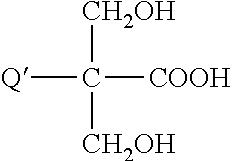Inkjet inks for textiles containing crosslinked polyurethanes and further containing additional reactive components
a technology of textiles and reactive components, applied in the direction of dyeing process, inks, textiles and paper, etc., can solve the problems of poor durability, inkjet printed fabrics that cannot tolerate the washing conditions required for textiles, and the textile industry's inability to adopt inkjet printing. to achieve the effect of improving washfastness and stain rating, and improving textile durability
- Summary
- Abstract
- Description
- Claims
- Application Information
AI Technical Summary
Benefits of technology
Problems solved by technology
Method used
Image
Examples
examples
[0158]Tests used to characterize the polyurethane dispersoids, the inks and the printed textiles were those commonly used in the art. Some specific procedures are listed
[0159]Printing and Testing Techniques
[0160]Inkjet printers used in the following examples were:
[0161](1) a print system with a stationery print head mount with up to 8 print heads, and a media platen. The printheads were from Xaar (Cambridge, United Kingdom). The media platen held the applicable media and traveled underneath the print heads. The sample size was 7.6 cm by 19 cm. Unless otherwise noted this print system was used to print the test samples.
[0162](2) Seiko IP-4010 printer configured to accept fabrics
[0163](3) DuPont® Artistri® 2020 printer.
[0164]The fabrics used were obtained from Testfabrics, Inc, (Pittston Pa.) namely: (1) 100% cotton fabric style # 419W, which is a bleached, mercerized combed broadcloth (133×72); (2) Polyester / cotton fabric style # 7435M, which is a 65 / 35 poplin mercerized and bleached...
PUM
| Property | Measurement | Unit |
|---|---|---|
| viscosity | aaaaa | aaaaa |
| surface tension | aaaaa | aaaaa |
| weight ratio | aaaaa | aaaaa |
Abstract
Description
Claims
Application Information
 Login to View More
Login to View More - R&D
- Intellectual Property
- Life Sciences
- Materials
- Tech Scout
- Unparalleled Data Quality
- Higher Quality Content
- 60% Fewer Hallucinations
Browse by: Latest US Patents, China's latest patents, Technical Efficacy Thesaurus, Application Domain, Technology Topic, Popular Technical Reports.
© 2025 PatSnap. All rights reserved.Legal|Privacy policy|Modern Slavery Act Transparency Statement|Sitemap|About US| Contact US: help@patsnap.com



